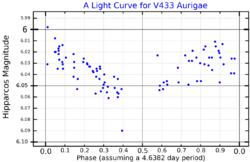Astronomy:V433 Aurigae
From HandWiki
Short description: Star in the constellation Auriga
| Observation data Equinox J2000.0]] (ICRS) | |
|---|---|
| Constellation | Auriga |
| Right ascension | 05h 39m 18.3132s[2] |
| Declination | +29° 12′ 54.788″[2] |
| Apparent magnitude (V) | 6.02–6.06[3] |
| Characteristics | |
| Spectral type | B2IV-V[4] |
| U−B color index | −0.5 |
| B−V color index | +0.16 |
| Variable type | SPB |
| Astrometry | |
| Radial velocity (Rv) | 22.90 ± 1.9[5] km/s |
| Proper motion (μ) | RA: −0.82[6] mas/yr Dec.: −7.11[6] mas/yr |
| Parallax (π) | 1.0114 ± 0.1708[2] mas |
| Distance | approx. 3,200 ly (approx. 1,000 pc) |
| Details | |
| Luminosity | 322[7] L☉ |
| Temperature | 7400[7] K |
| Other designations | |
| Database references | |
| SIMBAD | data |
V433 Aurigae is a variable star in the constellation Auriga. It is a slowly pulsating B star (SPB) that ranges from apparent magnitude 6.02 to 6.06 over 4.6 days.[3] Using a Hipparcos-derived distance of about 1,060 light-years (324 pc), it shines with a luminosity approximately 322 times that of the Sun and has a surface temperature of 7400 K.[7] However, measurements by Gaia indicate a much higher distance of 3,200 light-years (980 pc).[2]
References
- ↑ "Hipparcos Tools Interactive Data Access". ESA. https://www.cosmos.esa.int/web/hipparcos/interactive-data-access.
- ↑ 2.0 2.1 2.2 2.3 Brown, A. G. A. (August 2018). "Gaia Data Release 2: Summary of the contents and survey properties". Astronomy & Astrophysics 616: A1. doi:10.1051/0004-6361/201833051. Bibcode: 2018A&A...616A...1G. 3442900661273401600 Gaia DR2 record for this source at VizieR.
- ↑ 3.0 3.1 Watson, Christopher (4 January 2010). "V433 Aurigae". The International Variable Star Index. American Association of Variable Star Observers. http://www.aavso.org/vsx/index.php?view=detail.top&oid=4195.
- ↑ 4.0 4.1 "V433 Aur". SIMBAD. Centre de données astronomiques de Strasbourg. http://simbad.u-strasbg.fr/simbad/sim-basic?Ident=V433+Aur.
- ↑ Gontcharov, G. A. (2006). "Pulkovo Compilation of Radial Velocities for 35495 Hipparcos stars in a common system". Astronomy Letters 32 (11): 759–771. doi:10.1134/S1063773706110065. Bibcode: 2006AstL...32..759G.
- ↑ 6.0 6.1 van Leeuwen, F. (2007). "Validation of the new Hipparcos reduction". Astronomy and Astrophysics 474 (2): 653–664. doi:10.1051/0004-6361:20078357. Bibcode: 2007A&A...474..653V.
- ↑ 7.0 7.1 7.2 McDonald, I.; Zijlstra, A. A.; Boyer, M. L. (2012). "Fundamental Parameters and Infrared Excesses of Hipparcos Stars". Monthly Notices of the Royal Astronomical Society 427 (1): 343–57. doi:10.1111/j.1365-2966.2012.21873.x. Bibcode: 2012MNRAS.427..343M.
 |


